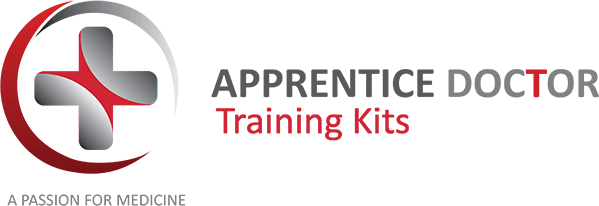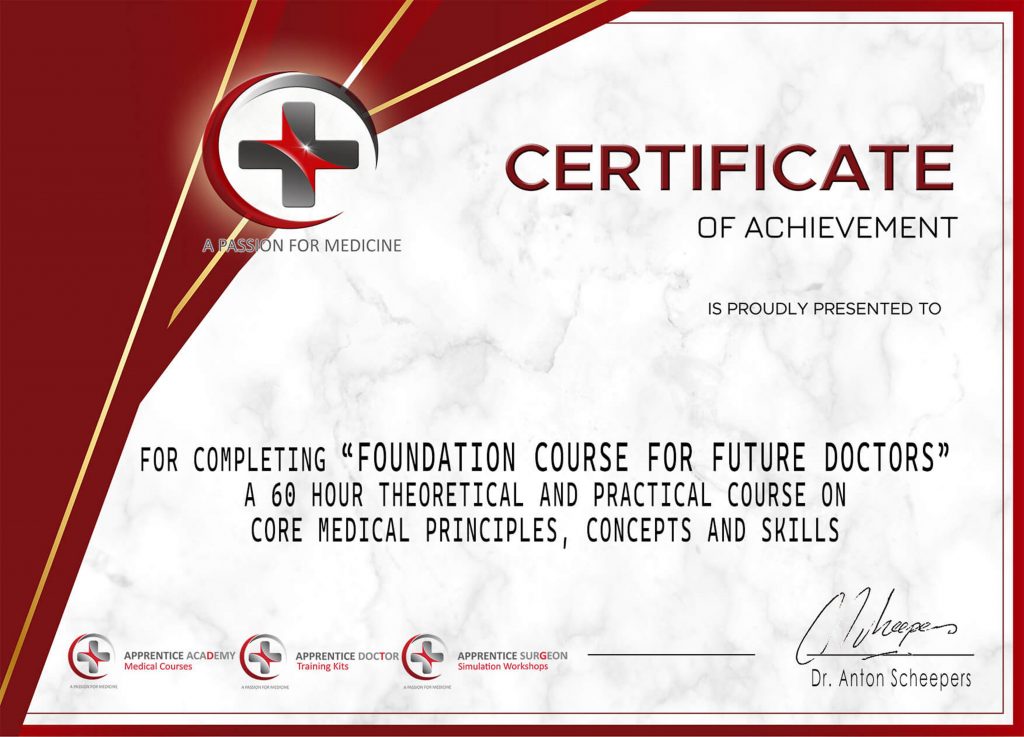Perform more than 50 fun practical projects at home and gain dozens of medical skills.
The Kit

Click here to order your Apprentice Doctor® “For Future Doctors” Simulation Kit
The Course
Perform more than 50 fun practical projects at home and gain dozens of medical skills.
After completing the Apprentice Doctor Academy Foundation Medical Course, students should have a good understanding of:
- The basic principles of conducting a medical examination
- An understanding of how to use several medical instruments and items
- The basic human anatomy and physiology of the eleven bodily systems
- The systematic approach in diagnosing diseases
- An understanding of medical ethics
- The importance of taking a thorough medical history
- The meaning of multiple medical terms (medical terminology)
- Various careers in medicine and healthcare
In addition to this, the student will have the following healthcare/medical skills:
Hand Hygiene
- Hand washing
- Applying alcohol hand-rub
- Donning and doffing gloves
Distinguish between normal and abnormal bodily sounds
- Heart sounds
- Gastro-intestinal sounds
- Respiratory sounds
- Joint sounds
The student will be able to assess a patient’s vitals
- Heat rate
- Body temperature
- Respiratory rate
- Blood pressure
The student will be able to examine various bodily parts
- The eye
- The ear
- The skin, hair, and nails
- The mouth
- The abdomen
- etc.
The student will be able to elicit neurological reflexes
- The Patellar Reflex
- The Babinski reflex
- The Pupil-light reflex
Other medical skills (perform and interpret)
- Urinalysis
- Pulse Oximetry
The student will have a working understanding of the following topics
- The body’s water balance
- The basic principles of airway management
- Emergency medicine and trauma
- Burn injuries
- Growths (tumors)
- Several metabolic diseases
- Many infectious diseases
Who Should Enroll In This Course?
– High School students in Grade 10 to 12
– Students at premed years 1-4 levels.
Setting
Home-based learning
Time Allowed
Please check your subscription details in your profile to see when your course access expires.
Duration
+-60 Hours (including practical projects).
The Apprentice Doctor Academy recommends that the student not rush through the course (not more than 3 hours per day) to allow for consolidation of the information. The course could be done in less than a week with full-time study; however, it is recommended that you not rush and instead allow the information to consolidate in your mind.
Furthermore we recommend that you briefly review the previous day’s work before continuing each day. This will also consolidate the knowledge in your mind.
Requirements/Instructions
— Register with Apprentice Doctor Academy
— Enroll in Course
— Simulation Kit (optional but recommended to complete the practical projects and practice the techniques you learn)
Certified Credits
Equivalent to sixty shadowing hours

Warnings
– The Apprentice Doctor® Foundation Course and accompanying Simulation Kit (including all items and instruments in the kit) are exclusively intended for educational and training purposes. No instrument or item may be used in a real clinical medical setting (emergency or otherwise).
– Without a formal medical qualification you may open yourself to medico-legal litigation if applying these techniques on the public.
– The surgical gloves contain latex. We do supply latex-free gloves as an alternative on request.
– The Apprentice Doctor® Foundation Course and Simulation Kit is suitable for students over 13 years of age. Adult supervision is recommended for students below the age of 18 years.
